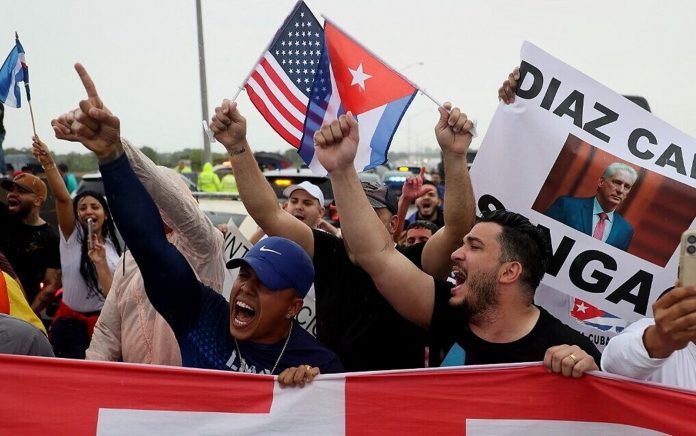Thousands of people took to the streets in Cuba, mid-July. This was the most widespread protest in the Island country since 1994. There have been different views on why these demonstrations took place and their significance.
Capitalists of all shades and stripes describe it simply as a popular revolt against “Communism.” Perspectives on the socialist left have been more divergent. At the same time, there is a common appreciation of the economic blockade’s excruciating impact on Havana’s ruling regime.
For many activists in Nigeria and across the world, the protesters were merely dancing to the tune of music played by the United States empire, and particularly its cloak and dagger Central Intelligence Agency (CIA). After all, apart from the inhuman blockade, several attempts have been made to topple the Communist Party of Cuba’s regime over the last six decades.
However, a more critical perspective should aim to understand the situation in the totality of its development. A step in this direction can be found in the statement published by Communists, a heterogeneous group of independent-thinking Cuban Marxists.
The group pointed out that Cuba has never faced a situation like the protests there on 11 July, since the revolutionary triumph of 1959. It was far bigger, wider, and more intense than the 1994 protests. And while it started as peaceful demonstrations, it eventually involved violence on the parts of both the protesters and the regime.
They listed nine essential characteristics of the protests. The first on this list is that “most protesters were not linked to counterrevolutionary organizations, now were the protests led by counterrevolutionary organizations.”
This does not mean that counterrevolutionaries, mainly based in the United States, seized the opportunity to promote propaganda online to deepen the protest mode. But the primary trigger of anger was material.
There was a “shortage of food and health products” as the country battled its worst economic crisis in three decades amidst a worsening COVID-19 situation. It is thus not surprising that “the protests originated in the working-class neighborhoods with the greatest social problems.”
In 2020 alone, the Cuban economy shrunk by 11%. And thus far, in 2021, it has reduced by another 2%. Countries like Venezuela, which defy the US embargo and favorably trade with Cuba, face economic crises.
The tourist industry, a primary foreign exchange earner, has also dried out due to the pandemic. The same goes for remittances from Cubans abroad, which has decreased considerably as migrant workers battle to survive in a COVID-19 world, living little to send home.
The political legitimacy of the regime is also diminishing considerably. The younger generation is less likely to be swayed by the CPC’s propaganda machine in today’s world. Not surprisingly, many of the protesters were youths.
The Communists did, however, point out that “the protests did not represent a majority” of the population. The legacy of Fidel Castro and the revolution he and his comrades led still looms large in people’s minds, particularly of the older generation.
And while the demonstrations started in working-class quarters, the lumpenproletariat and not workers played a more significant role. Their slogans were more like “down with the dictatorship,” “homeland and life,” and such. Socialist demands were not made.
To understand the significance of the clear picture of what is happening in Cuba, in the light of protests, we as working-class activists and socialists need to have a clearer understanding of what has happened in Cuba.
Revolutionary youths led by Fidel Castro, Che Guevara, and other leading members of the July 26 Movement led a 3-year guerrilla struggle that toppled the US-backed Fulgencio Batista regime on 1 January 1959. This was a gallant feat of national liberation from United States imperialism.
First, this was, however, not a socialist revolution, nor has Cuba been socialist. This might sound strange to several activists in Nigeria, who, like us, have stood up and continue to stand up for Cuba against Yankee imperialism. However, it is of fundamental importance for understanding what is happening in Cuba and informing our political strategy as revolutionary socialists.
The socialist revolution is, to put it simply, the self-emancipation of the working class. Working-class people cannot be liberated by revolutionaries acting on their behalf, no matter how well-intentioned. The key tasks of revolutionary socialists are thus to catalyze class consciousness in workers and help them forge independent organizations to fight for themselves and conquer power from the capitalists.
Second, Cuba has been a state capitalist country, ruled by a class of bureaucrats, represented by the CPC. It is impossible to have a socialist island in the sea of a capitalist world. Socialism will triumph only as an international system. The ups and downs of the Cuban economy reflect its unavoidable integration into the world capitalist system, despite the US embargo. Capitalism is a global system that sucks in all and every country in world trade and production.
Furthermore, Cuba has been an inspiration for millions of activists. It has recorded astonishing feats in promoting social and economic rights. Despite the material challenges faced by the country, its achievements in providing education and health are indisputable. This is a major reason why the regime still has a significant proportion of the population, particularly those who saw the era before the collapse of the Soviet Union made it harder for the regime to pursue its social-economic goals.
But socialism is not only about bread. Working-class people deserve both bread and the roses of freedom. We will not be telling ourselves the truth if we maintain the propaganda that it has been an island of the fullest of democracy. Socialism, as Karl Marx and Friedrich Engels stressed in the Communist Manifesto, is the working-class’ conquest of the fullest of democracy.
Workers’ democracy is to socialism what oxygen is to the body, as Leon Trotsky pointed out. When the body is deprived of oxygen for too long, it does not simply degenerate or become deformed; it becomes lifeless corpse. In the name of the working-class, the rule of a bureaucracy leads gradually but surely to erosion of its political legitimacy.
While most of the population might not have supported the July protests, the fire might be more encompassing next time. The bureaucratic regime of the CPC might likewise move further sideways from state capitalism to a China-like hybrid of liberal and state capitalisms under pressures to maintain control. This would neither solve the problem or the need for a socialist revolution in Cuba as part of a global revolutionary movement to overthrow capitalism worldwide.
The greatest tragedy is the weakness of revolutionary socialist ideas and organizations in the working class, independent of the ruling bureaucracy. This is due to the regime’s suppression of dissident Marxist thought over the years. It is why the lumpenproletariat played a more significant role than the proletariat, this time.
The greatest challenge in Cuba today is thus building a genuinely revolutionary socialist movement of the working class, from below. If done, the future upsurges might not result in confused and manipulated endings that would erode the gains of Cuba’s national liberation revolution.
by Baba AYE









